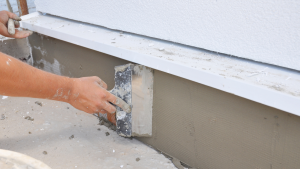One of the most frequent issues homeowners confront
is stucco repair. It might take a long time and be a difficult procedure.
In the next article, I will go through the fundamentals of stucco repair.
Step 1: Determine if your stucco needs to be patched.
A small coating of sand is applied first, followed by two applications of cement. This substance is blended with water to make a paste. When it dries, it adopts the form of the mold it was put in.
If your stucco starts flaking, you’ll need to scrape it off and install a fresh coat.
Rather of removing the old stucco, repair it.
Get expert assistance if you need clarification on whether you need to repair your stucco.
Step 2:Take off the current stucco.
In most circumstances, repairing stucco entails removing the old stucco and adding a fresh coat.
The hardest part of the procedure is this step, which entails removing the old stucco and adding a fresh coat. For this, a variety of cutting equipment must be used together with safety measures.
Step 3: Put new stucco on again.
It’s time to put the new stucco on after the old one has been taken off.
Generally speaking, a trowel may be used to apply stucco. However, it’s critical to understand that stucco is a difficult material to work with and that trowels could be better tools.
A stiff-bristle brush is useful in various situations.
If you have a trowel, apply the stucco in the same pattern as the original. On a wet surface, however, avoid using a trowel.
Step 4: The area around the door should be stuccoed.
The repair work mustn’t hurt the door.
A great way to achieve this is to use new cement around the walls and entryway while allowing some room around the door.
until the fresh plaster is dry. Fix the small area around the door.
Step 6: Put the sealant back on.
After cleaning up the dust and dirt, it’s time to put the sealant back on.
Most of the time, you need to reapply the sealer after a few weeks or months.
Step 7: Reapply additional paint if necessary.
When painting a room, it is critical to prevent having paint peel off the walls.
Apply a thin coat of paint finish to the walls to keep the paint from flaking.
You could also put a little paint on the wall.But only a perfectly dry wall will allow for this.
Step 8: Replace the adhesive.
It is critical that the roof not be damaged if it is leaking.
The roof is sealed to keep water out of the walls and ceilings.
Caulking comes in a variety of colors and is easy to apply.
All you need is a caulking gun.
Step 9: tidy up
After applying the caulking, you may clean up.
Remove any dust and dirt using a wide brush.
The leftover dust may then be removed using a damp cloth.
You may also use a vacuum cleaner to remove loose dust and dirt.




